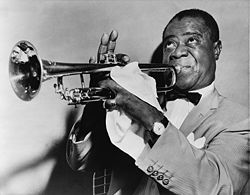
Listen
Louis Armstrong version
White Stripes version
About
“St. James Infirmary Blues” is an American folksong of anonymous origin, though sometimes credited to the songwriter Joe Primrose (a pseudonym for Irving Mills). Louis Armstrong made it famous in his influential 1928 (0r 1929?) recording. “St. James Infirmary Blues” is based on an 18th-century traditional English folk song called “The Unfortunate Rake” (also known as “The Unfortunate Lad” or “The Young Man Cut Down in His Prime”), about a soldier who uses his money on prostitutes, and then dies of a venereal disease.
Trivia
- The title is said to be derived from St. James Hospital in London, a religious foundation for the treatment of leprosy. There is some difficulty in this since it was closed in 1532 when Henry VIII acquired the land to build St. James Palace. Another possibility is the Infirmary section of the St James Workhouse which was opened in 1725 by the St James Parish in Poland Street, Piccadilly and continued well into the nineteenth century. This St James Infirmary was contemporaneous with the advent of the song.
- Variations typically feature a narrator telling the story of a young man “cut down in his prime” (occasionally, a young woman “cut down in her prime”) as a result of morally questionable behaviour. For example, when the song moved to America, gambling and alcohol became common causes of the youth’s death.
- More recently, The White Stripes cover the song on their self-titled debut album, as does Van Morrison on What’s Wrong with This Picture?, and actor Hugh Laurie on his 2011 album Let Them Talk. Isobel Campbell has also recorded a version of the song.
Another classic Blues track, I don’t think I’ve heard this particular track before.
Louis’ version is a lot darker than the White Stripes’, but I suppose that’s to be expected.
The opening has an almost funeral dirge feel to it, which is brought back in what I suppose is the bridge. Very gloomy. Proper blues.
Love it.
I love this. The interplay between the trombone and the cornets/trumpets is just delightful, creates a really vivid energy of the vices that the protagonist is victim of. Then the voice permeates throughout the entire instrumentation and drenches it in melancholy after the intro which yes does have a funeral like quality. This is just fantastic, I am loving this list
Good point guys – this song wouldn’t be out of place at a New Orleans funeral (it really has that Dixieland sound throughout, with as Paul said, the trombones, cornets and trumpets). And no, I hadn’t heard this one before either despite the fact it’s apparently a blues staple (I guess I’m getting a bit of an education here!).
The really intriguing aspect of this song for me is its historical UK origins. I guess it’s a timeless parable – the vices may have changed, but the moral message has been the same for hundreds of years.
And finally, I’m beginning to realise just what a huge influence Louis Armstrong had on the genre and pop music in general – both as a musician and vocalist. I’d always pictured him from around the ‘50s and ’60s, so it was surprising to learn he was also right there from the beginning (around WW1).
Absolutely, funeral dirge. Took me straight back to a 007 film, early 70’s, Connery I think. There is a funeral procession in New Orleans, everybody freezes then it turns into a gunfight. Familiar to anyone? very tired and just free associating. I will look it up eventually.
I think you thinking of “Live and Let Die” was Roger Moore though. A British Secret Agent (not 007) is watching a funeral procession. He asks a local who walks by what is going on and is promptly shot. The funeral then turns into a party as the body is taken away.
007 convo already in here…I think there will be more by the time we get to 1001